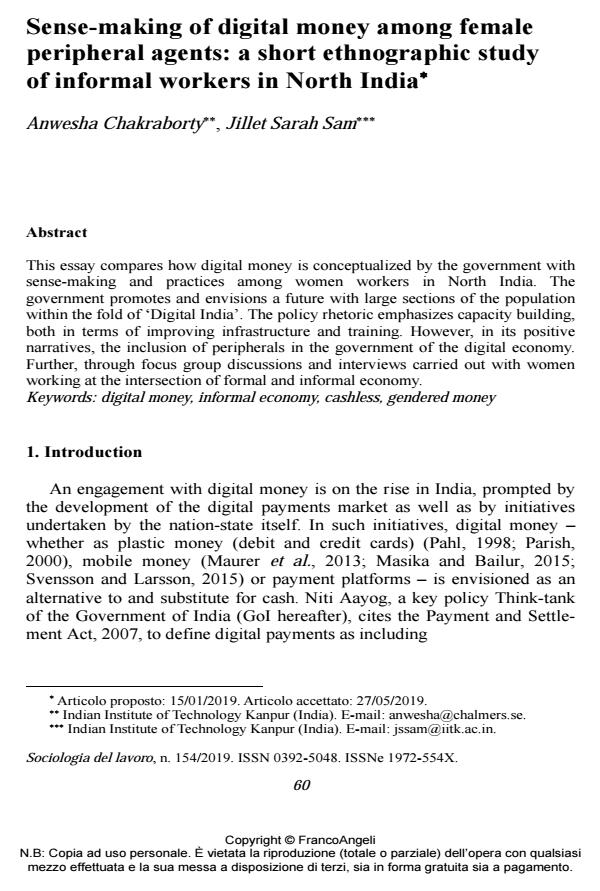Sense-making of digital money among female peripheral agents: a short ethnographic study of informal workers in North India
Titolo Rivista SOCIOLOGIA DEL LAVORO
Autori/Curatori Anwesha Chakraborty, Jillet Sarah Sam
Anno di pubblicazione 2019 Fascicolo 2019/154
Lingua Inglese Numero pagine 19 P. 60-78 Dimensione file 197 KB
DOI 10.3280/SL2019-154004
Il DOI è il codice a barre della proprietà intellettuale: per saperne di più
clicca qui
Qui sotto puoi vedere in anteprima la prima pagina di questo articolo.
Se questo articolo ti interessa, lo puoi acquistare (e scaricare in formato pdf) seguendo le facili indicazioni per acquistare il download credit. Acquista Download Credits per scaricare questo Articolo in formato PDF

FrancoAngeli è membro della Publishers International Linking Association, Inc (PILA)associazione indipendente e non profit per facilitare (attraverso i servizi tecnologici implementati da CrossRef.org) l’accesso degli studiosi ai contenuti digitali nelle pubblicazioni professionali e scientifiche
This essay compares how digital money is conceptualized by the government with sense-making and practices among women workers in North India. The government promotes and envisions a future with large sections of the population within the fold of ‘Digital India’. The policy rhetoric emphasizes capacity building, both in terms of improving infrastructure and training. However, in its positive narratives, the inclusion of peripherals in the government of the digital economy. Further, through focus group discussions and interviews carried out with women working at the intersection of formal and informal economy.
Questo saggio mette a confronto il modo in cui il denaro digitale è stato concettualizzato dal Governo Indiano e l’interpretazione che ne hanno dato le lavoratrici dell’India del Nord. Il Governo Indiano ha promosso e immaginato un futuro capace di portare ampie fasce della popolazione all’interno della "Digital India". La retorica politica ha enfatizzato l’idea di "capacity building", intesa sia in termini di miglioramento delle infrastrutture che di miglioramento delle opportunità di formazione capaci di consentire alla popolazione indiana in grado di utilizzare le transazioni digitali. Tuttavia, nel suo racconto positivo, l’inclusione delle donne è menzionata solo di sfuggita, rendendole soggetti periferici nella visione governativa di un’economia digitale. Il presente articolo stabilisce, attraverso focus group e interviste con donne che lavorano all’incrocio tra economia formale e informale, che le nostre intervistate sono agenti periferici a causa delle strutture economiche e sociali che le vincolano dall’accesso formale ed effettivo al denaro digitale.
Parole chiave:Denaro digitale, economia informale, denaro senza contanti, denaro di genere
- Addressing corruption through visual tools in India: the case of three civil society initiatives and their Facebook pages Anwesha Chakraborty, Alice Mattoni, in Visual Studies /2023 pp.803
DOI: 10.1080/1472586X.2023.2239759 - Improving Transparency in Service Delivery to Fight Corruption? Mapping Multi-Stakeholder Voices on Digitization in the Indian Public Healthcare Sector Anwesha Chakraborty, Ina Kubbe, in American Behavioral Scientist 00027642241268555/2024
DOI: 10.1177/00027642241268555 - Off-platform Social Networks and Gig Work During the COVID-19 Pandemic in India Rajorshi Ray, Jillet Sarah Sam, in Journal of South Asian Development /2023 pp.359
DOI: 10.1177/09731741231191876
Anwesha Chakraborty, Jillet Sarah Sam, Sense-making of digital money among female peripheral agents: a short ethnographic study of informal workers in North India in "SOCIOLOGIA DEL LAVORO " 154/2019, pp 60-78, DOI: 10.3280/SL2019-154004